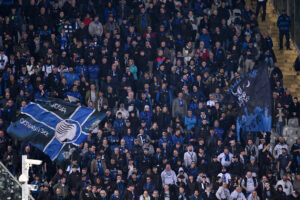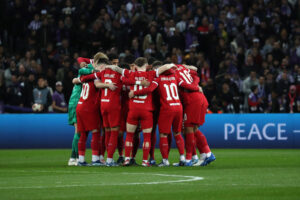Red Bull have firmly put their stamp on the football map in the past decade. Their story is one of toil, tenacity and triumph.
The Red Bull Story
Manufactured Success
Football supporters are a loyal bunch. Loyal beyond comprehension with a devotion to their club’s crest and colours. A tradition and heritage which tugs at supporters’ hearts who love their club unconditionally. And their football club is much like a blooming flower – growing organically throughout time, nurtured thanks to its staff and, most importantly, its fans.
However, the modern-day has seen the rise in franchise teams which are manufactured towards success. And there is one group who have made waves in several sports to capture attention through successful exploitation. By positioning themselves effectively, they have put their brand firmly on the sporting map. Sports such as Formula One, Air Racing and BMX have all been enhanced by the multinational drinks company Red Bull. Their pursuit of sport, and in particular extreme sport, goes hand in hand with their aggressive philosophy.
Returning to football, Red Bull targeted clubs for years. Their patience received a timely reward when, in 2005, the wealthy global drinks magnet burst onto the football scene, acquiring SV Austria Salzburg and rebranding them as Red Bull Salzburg. This was their launchpad, propelling them to rebrand four further clubs.
The First Big Move for Red Bull
Their most successful remodelling has been RB Leipzig. In 2009, the team began life as SSV Markranstädt and languished in the fifth tier of German football. The club was founded in 1990 and part of a wider network of sports clubs including volleyball, badminton and table tennis. Prior to the takeover, SSV Markranstädt were a modestly run football club that had won three lower-level championships in 1995, 1999 and 2007.
Therefore, the Red Bull organisation saw an opportunity with a major team lacking in eastern Germany. They identified the city of Leipzig as a prime football destination, second only in size to its capital, Berlin. Their business model was aimed at securing a place in the Bundesliga within eight years. Right on schedule, in 2017, the club achieved a historic promotion to the elite.
Since then, their progress has skyrocketed. Fast forward four years and Leipzig are a dominant force in the Bundesliga and last season achieved a Champions League semi-final berth. Leipzig are now a staple European team with the fruits of their loom paying off handsomely. But how did their strategy work so well?
The Seeds of Success of the Red Bull Story
The blueprint of success starts with a highly sophisticated interlinking of Red Bull’s clubs working together towards a common philosophy. A philosophy in which each club knows not only its own role but also how to aid its sister club.
In addition, there is a clear organisation structure recognising where each club is in the food chain of importance. For example, Salzburg know they are Leipzig’s feeder club and play that stepping stone role to perfection. This marriage between the respective clubs under the Red Bull umbrella allied to the creativity of these footballing takeovers has culminated with unprecedented success. As importantly, it is sustainable. This is the route for the Red Bull family, with each cog playing a vital role of togetherness in a dynamic and forward-thinking way.
Aggressive, Identity and Clarity: The Fundamental Pillars
From a business standpoint, Red Bull adopts an aggressive strategy and is not afraid to make tough decisions. Strong leadership is critical in building solid foundations through well thought out strategic planning, both short and long-term. Patience is a definite virtue of the company’s ethos. Red Bull pride their clubs’ development on being a gradual journey to the destination. Each of their clubs started their respective journeys over a decade ago – demonstrating the company’s appetite for success is long-term to ultimately reach the summit of world football.
All of Red Bull’s teams possess the same identity: identical shirt colours, club crest, nicknamed ‘The Bulls’ and all play in the Red Bull Arena. Clarity is key.
The Red Bull Inclusive Transfer Market
Successful scouting is another key ingredient paramount to their progress. There have been many notable inter-house transfers due to their renowned cultivation, including Guinea’s Naby Keïta from Salzburg to Leipzig. The midfielder signed for the Austrians for just £1.35 million before moving to Germany for £26.78 million. He would spend two successful years in the Bundesliga. Under Ralph Hassenhutl, he was instrumental in the club finishing second and scored 14 goals in 58 appearances. His excellent form eventually took him to Liverpool to the tune of £54 million – a tidy profit for both Red Bull clubs.
More recently, Hungarian international midfielder Dominik Szoboszlai moved from firstly FC Liefering, Salzburg’s feeder club, for just £450,000. Soon after, he earned his promotion to Salzburg. There, he established himself with some crucial performances to help his side to three consecutive league titles. He received the Player of the Season award for 2019/20 and netted on his debut in the Champions League. His 16 goals in 56 games took him to Leipzig last January for £18 million.
The Conveyor Belt of Talent Continues
The conveyor belt of talent shows no sign of letting up. Another player in Leipzig’s ranks has been their prized asset: French defender Dayot Upamecano. He followed the same well-trodden path of Szoboszlai; signing for Salzburg for £2.2 million before leaving for £10 million. After over 100 games for Leipzig and breaking into the French squad, now his value is much higher, yet his release clause is just £37.4 million. This was recently triggered by Bayern Münich, who moved swiftly to conclude the deal for the highly sought-after defender.
Twenty-two-year-old Tyler Adams became the first American to play for the Bulls in Germany, exchanging New York Red Bulls for Leipzig with notable success.
Red Bull are well adept at recycling their roster. A footballing case of “I’ll scratch your back if you’ll scratch mine.”
Successful Scouting System Key to the Red Bull Story
Not only do the clubs reap the benefits of their own, but have that keen eye for talent with Red Bull being an excellent breeding ground for promising footballers. Current Chelsea striker Timo Werner is a prime example having been bought from his native Stuttgart for £10 million and sold from Leipzig to the Londoners for £47.5 million. As was the case with Liverpool forward Sadio Mané – arriving from Metz for £3.6 million and departing for Southampton for £10 million.
Most notable is Norwegian star Erling Braut Haaland. He arrived at Red Bull Salzburg from Molde FK for £7.2 million and 17 goals in 16 games awoke the attention of Europe. Just a year later, it was Borussia Dortmund who came knocking with £18 million in hand to snatch the striker away. It was another great piece of business for Red Bull. It is a project in the peak of its powers – elevated by the wings of ingenuity and thinking outside the box.
This is the story of Red Bull’s involvement in football. This article is part two of a two-part series. Click here to read part two.
Main Photo






